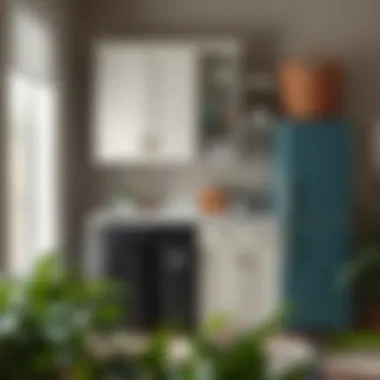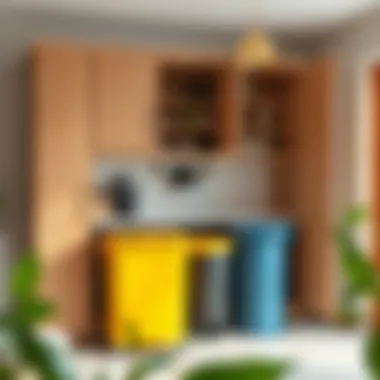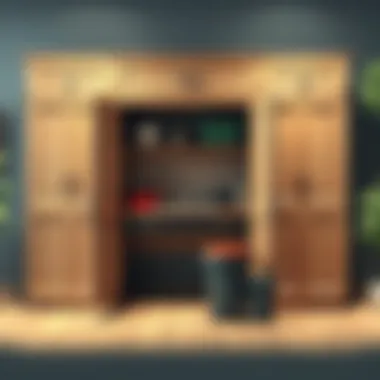Trash Cans and Recycling Cabinets for Sustainable Living


Intro
In the ongoing quest for a harmonious home, the importance of trash cans and recycling cabinets is often overlooked. These are not just mere receptacles for waste; they are integral components shaping the efficiency and sustainability of our living spaces. Understanding their value goes hand in hand with modern organization and a commitment to environmental responsibility.
But why should we care about the designs and materials of these units? Well, they play a crucial role in maintaining aesthetic appeal while promoting responsible waste management. As lifestyles evolve towards minimalism and sustainability, the choices we make regarding trash cans and recycling cabinets say a lot about our priorities. This exploration invites homeowners, designers, and eco-conscious individuals to reevaluate their current systems, ensuring that functionality does not get lost in the shuffle of domestic clutter.
You might be thinking, "What’s the big deal? It’s just trash," but consider this: our waste management strategy can significantly impact our living environment. So let’s peel back the layers and delve deeper into the design trends and functionality of these household essentials, all while keeping sustainability front and center.
The Importance of Trash Cans and Recycling Cabinets
In the daily hustle and bustle of life, trash cans and recycling cabinets might seem like mere afterthoughts, but their significance stretches far beyond their humble appearances. They serve as unsung guardians of home organization and environmental sanity. Recognizing their importance encourages us to rethink our approach to waste management and sustainability.
Defining Waste Management
Waste management is essentially how we handle our refuse—from production to disposal and everything in between. It encapsulates processes such as reduction, reuse, and recycling. A good trash can isn’t just about containment; it plays a pivotal role in this cycle. For instance, having clearly labeled recycling compartments makes it easier to segregate plastics from organic waste, directly influencing how well we manage our garbage.
When you think about it, defining waste management in your home could start with selecting the right trash can. Choosing a can with multiple compartments allows for effective sorting right at the source. This small step can lead to significant changes in how waste is processed at larger facilities, reducing the amount that ends up in landfills.
Sustainability Considerations
Sustainability is a buzzword floating around these days, but it is a vital concept that should guide our daily decisions. The challenge lies in making choices that reduce our footprint on the planet, and trash cans play a surprising role in this endeavor.
- Material matters: Opting for trash cans made from recycled or eco-friendly materials minimizes the resources needed for production and reduces overall waste.
- Efficiency in recycling: The more accessible our recycling options are, the more likely we are to use them. Well-designed recycling cabinets positioned around the home encourage habits that support sustainability.
- Composting options: Adding a compost bin into the mix also enhances sustainability. Food scraps that would otherwise clog landfill sites can be turned into nutrient-rich soil for gardens.
By thoughtfully selecting trash can designs, we align our waste management practices with broader environmental goals. Consider this: making these choices not only reflects personal responsibility, but can inspire those around us to follow suit.
Organization and Home Aesthetics
If you’ve ever seen a cluttered kitchen with trash bags haphazardly strewn about, you know the importance of keeping waste organized. The functionality of a trash can or recycling cabinet extends into the realm of aesthetics, contributing to the overall harmony of a living space.
- Design elegance: Many modern trash cans come in sleek designs that can blend seamlessly with contemporary décor. Whether your style leans towards minimalist or something more eclectic, there is lots of options that don’t scream “trash.”
- Strategic placement: Finding the right spots for trash and recycling cabinets not only keeps your space tidy but enhances the flow and functionality of your home's layout. For instance, positioning recycling bins by the sink encourages proper disposal during meal prep.
- Customizable solutions: Some cabinets can even be integrated into cabinetry, providing a flush look that maintains the cleanliness of the space. This can be particularly effective in kitchens and home offices, where aesthetics and organization are key.
Effective organization promotes a smoother daily routine and reflects thoughtful design choices that emphasize both utility and beauty.
In summary, the importance of trash cans and recycling cabinets cannot be overstated. They serve as fundamental components in our journey towards better waste management, support sustainability while enhancing the aesthetic appeal of our homes. Engaging with these elements leads to more organized and conscientious living spaces.
Understanding Different Types of Trash Cans
When it comes to waste management in the home, having the right trash cans can make all the difference. Understanding the varied types of trash cans on the market is essential, as each serves a specific purpose and meets different needs. Homes these days are not just places to live; they reflect personal taste and a commitment to sustainability. Thus, a well-chosen trash can is more than just a receptacle for rubbish; it's a tool that supports organization, hygiene, and eco-friendliness.
Standard Trash Cans
Standard trash cans, the most common type found in households, come in various shapes, sizes, and materials. Typically made of plastic or metal, they serve as everyday receptacles for non-recyclable waste. One can hardly underestimate their practicality. They are available with different lid types – from swing tops to simple, open designs – allowing homeowners to select a style that fits their routine and kitchen aesthetics.
When choosing a standard trash can, consider these factors:
- Capacity: Standard sizes range from small to large, based on the amount of waste your household generates. A family of four may require a can that holds at least 13 gallons to reduce the frequency of emptying it.
- Placement: Think about where the trash can will sit. Under-the-sink models are great for conserving space, while countertop cans might fit better in smaller kitchens.
- Durability: Some low-quality models can wear fast. Look for ones with a solid base and heavy-duty construction to ensure they stand the test of time.
Touchless Trash Cans
The rise of technology has propelled the development of touchless trash cans into popular choice. These cans boast motion sensors that open the lid automatically, reducing contact with surfaces that may harbor germs. In today's health-conscious world, this feature can be particularly appealing.
Some benefits of touchless trash cans include:
- Convenience: You can toss trash without needing to touch the lid, which is ideal when your hands are full or messy.
- Odor Control: Many models come with built-in odor management systems, keeping kitchens fresher.
- Stylish Designs: Available in sleek metal finishes or modern designs, they can enhance the decor of any kitchen.
Nevertheless, one should weigh the pros and cons; they can come with a higher price tag and may require batteries or charging, adding a layer of maintenance that traditional trash cans do not.
Compost Bins
Among the most sustainable options are compost bins, which allow households to manage food scraps and yard waste effectively. Composting not only reduces the amount of waste sent to landfills, but it also produces nutrient-rich compost that can be used in garden beds or potted plants.
When considering compost bins, think about:
- Type: Aerobic compost bins, which encourage oxygen flow, are essential for effective breakdown of organic matter. There are also worm bins for those interested in vermicomposting.
- Location: Ideally, compost bins should be placed in a convenient location, possibly outdoors, close to where kitchen scraps are generated.
- Material: Look for sturdy, weather-resistant materials such as recycled plastics or stainless steel that can withstand outdoor conditions.
Given that composting requires specific care and attention, anyone starting should educate themselves on the best practices for composting to ensure successful outcomes. The payoff, however, is significant not just for the environment, but also for the homeowner seeking to reduce their carbon footprint.
"The future of our planet depends on how we manage our waste today."
Understanding the different types of trash cans available is vital. Each serves its purpose and supports various aspects of organization and environmental sustainability. Making informed choices contributes to a cleaner home and planet.
Exploring Recycling Cabinets
Recycling cabinets offer an essential solution for managing waste in our homes. They act not only as storage for recyclables but also as a symbol of our commitment to sustainability. With ever-increasing awareness around the importance of reducing our environmental footprint, incorporating recycling cabinets into our homes has become more than a trend; it’s a necessity. Homeowners are starting to recognize that how we dispose of our waste reflects our values and beliefs regarding the health of our planet.
These cabinets address practical elements of waste management while also enhancing the aesthetic appeal of our living spaces. They fit neatly into kitchens, garages, or even utility rooms, creating organized systems for separating recyclables such as paper, plastics, metals, and glass. Moreover, they encourage everyone in the household to adopt sustainable practices.
Integrating a recycling cabinet isn’t just about functionality; it’s also about promoting awareness and education regarding recycling efforts. Many manufacturers are now providing options that incorporate convenient features, making it easier for families to participate in recycling programs. Therefore, exploring recycling cabinets is crucial for anyone looking to enhance their home organization while supporting eco-friendly practices.
Designs for Modern Homes


When it comes to selecting a recycling cabinet, design can play a pivotal role in how well it integrates with the aesthetic of a modern home. Manufacturers are stepping up their game to provide sleek, contemporary styles that complement kitchen appliances and furnishings. Many cabinets come in various finishes, such as brushed stainless steel or matte black, making them suitable for a range of interior styles, from rustic to minimalist.
For instance, some models feature pull-out compartments or built-in dividers, ensuring easy access and organization right where you need it. Other designs might emphasize eco-friendliness by using reclaimed wood or sustainable materials, further reflecting the values of responsible consumption. Ultimately, the design of the recycling cabinet should harmonize with your space while encouraging effective waste separation and management.
Choosing Materials
Selecting the right materials for recycling cabinets can greatly influence both their functionality and longevity. Many options exist among modern cabinets, from robust plastics to metals that are resistant to corrosion and rust.
- Stainless Steel: A popular choice due to its durability and ease of cleaning; it often features a sleek finish that fits well in most homes.
- Recycled Plastics: These environmentally friendly choices demonstrate a commitment to sustainability. They often come in vibrant colors and designs, encouraging recycling adoption.
- Wood: For those seeking a more organic look, wood cabinets can blend seamlessly into natural decor styles. It’s essential, however, to source wood that’s certified from sustainable forests.
The choice of material can also impact maintenance. For example, metal cabinets might require periodic tightening of screws, while plastic can become discolored over time if constantly exposed to sunlight.
Customization Options
Customization is increasingly becoming a trend for recycling cabinets, and for good reason. Many homeowners want recycling solutions that fit their unique needs. Some companies allow you to tailor your cabinet’s size, color, and internal configuration. For example, if you generate more paper waste than plastics, you might want a cabinet with larger compartments dedicated to paper collection.
Additionally, some manufacturers offer extras like lids that can minimize odors or wheels that make moving the cabinet simple, particularly when cleaning around it is necessary. This flexibility means that recycling cabinets can truly be designed for optimal effectiveness in your specific living space.
Moreover, incorporating labels or clear signage on or near the cabinet can further enhance usability, ensuring each member of the household recognizes where to place each type of recyclable material.
"The integration of recycling cabinets thoughtfully into our homes encourages not only clutter-free spaces but promotes a culture of sustainability among families."
By selecting the right design, materials, and customization options for recycling cabinets, homeowners can create a functional and appealing system that fosters environmentally responsible habits for years to come.
The Role of Size and Capacity
When it comes to trash cans and recycling cabinets, size and capacity are more than just numbers—they're key elements in creating an efficient and functional home. Proper sizing not only plays a critical role in determining how effectively you can manage waste but also keeps your living space organized and visually appealing. A well-thought-out trash can or recycling cabinet complements your home environment rather than cluttering it.
Evaluating Space Requirements
Before diving into the specifics of capacity, it is crucial to evaluate the available space in your home. Measure the area where you plan to place your trash can or recycling cabinet. A typical kitchen layout may need a pull-out recycling bin concealed within cabinetry or a sleek unit in a corner. Consider spaces such as:
Under-counter areas: Perfect for built-in solutions, where aesthetics matters just as much as functionality.
- Pantry and laundry rooms: Often forgotten, these spots can accommodate larger bins that stay out of sight.
- Family rooms or offices: Finding balance is key; you want it nearby but not in plain sight.
By assessing your available space and integrating your waste management solutions accordingly, you can avoid frustrating situations later on when your choice simply doesn’t fit.
Balancing Capacity with Usage
Capacity is another significant factor. Selecting a trash can or recycling cabinet based on expected usage helps strike a perfect balance between frequency of emptying and overall convenience. Here are some considerations:
- If you’re a household that generates a lot of waste, larger bins may be beneficial, but ensure they fit comfortably in the designated area.
- For smaller families or those who focus on minimizing waste, a compact solution could suffice, emphasizing sustainability.
- Clearly demarcating between recyclables and regular trash adds another layer of organization, reducing overflow and untidiness.
Think of it this way: a large garbage can that’s too cumbersome to maneuver is an invite for procrastination on taking out the trash. Conversely, a tiny bin might necessitate daily trips to the outdoor container, which could disrupt your routine. Finding the sweet spot in capacity tailored to your lifestyle enhances efficiency, making sure trash and recyclables find their way to their respective places with minimal fuss.
Functional Features to Consider
When it comes to the effectiveness of trash cans and recycling cabinets, functional features play a pivotal role in promoting both ease of use and sustainability. Understanding these features helps homeowners make informed choices that align with their lifestyle and environmental goals.
Pedal Mechanisms
Pedal mechanisms are an essential aspect to consider when choosing a trash can. These feature allows for hands-free operation, which is particularly useful when your hands are occupied, say from cooking or cleaning. It’s the kind of convenience that turns a mundane task into a simpler one. Additionally, the ergonomics catered by pedal designs reduces the likelihood of spills or messes—no more fumbling with lids while juggling trash bags. They come in various styles, ranging from sleek models that match modern aesthetics to more traditional designs. If a homeowner or designer places a premium on both functionality and looks, opting for a stylish pedal-bin can certainly keep appearances in check while ensuring ease of disposal.
Odor Control Technology
Odor control technology is another key feature worth attention. Trash bins can sometimes present a health hazard if they become a breeding ground for unpleasant smells. Investing in bins with built-in odor control, such as activated charcoal filters or airtight seals, could pay off immensely in maintaining the overall freshness of your living space. It’s simple: no one wants their kitchen smelling like last week’s dinner! Moreover, some models incorporate advanced technologies like touch-free sensors, which not only minimize direct contact but also enhance the effectiveness of odor management. Such features represent the intersection of health and technology, providing a cleaner, more pleasant home environment.
Segregated Compartments
When discussing recycling cabinets, segregated compartments are fundamental to effective waste management. These compartments allow users to separate different types of waste—be it compostables, recyclables, or general trash—with ease. The beauty of such organization cannot be overstated as it streamlines the recycling process. No more rummaging through the bin to sort things out later! For bigger households or gatherings, having designated spaces can significantly cut down on the chaos usually associated with waste disposal. Homeowners can feel good about doing their part for the planet, as these features inherently promote recycling and responsible waste management. Moreover, many modern designs come with clear labeling and color coding for each compartment, making it easy for every family member to participate.
"Investing in functional features can enhance both home aesthetics and environmental consciousness."
In the modern world, where organization meets sustainability, prioritizing these features not only elevates the user experience but also enhances the overall impact on waste management practices. Homeowners, interior designers, and eco-enthusiasts alike stand to benefit from comprehensively understanding these functional aspects.
Integration with Smart Home Technology
In today’s tech-savvy world, the integration of smart home technology into various aspects of daily life has become almost second nature. Trash cans and recycling cabinets are not exempt from this trend. By incorporating intelligent features, these essential home fixtures can significantly enhance organization, efficiency, and sustainability within household waste management systems.
One of the main advantages of integrating smart technology is the ability to streamline waste disposal and recycling processes. For instance, smart trash cans often come equipped with sensors that can automatically open the lid when someone approaches. This hands-free feature is not only convenient but also minimizes the spread of germs, which is crucial in maintaining a sanitary home environment, especially in kitchens.
Moreover, smart recycling cabinets can provide feedback through mobile applications or built-in displays. Homeowners can receive alerts about when to take out the trash or recycling or notifications about how much waste they’ve generated in a given period. This feature promotes a conscientious approach to consumption and waste, encouraging users to assess and possibly reduce their waste production.
In a world where every bit counts, this data becomes invaluable, not merely as numbers on a screen, but as a means to foster sustainable habits.
"The way we handle our waste reflects broader societal values. Smart home technology can pave the way toward more responsible consumerism."
Certainly, the seamless connection between these devices and users’ everyday lives adds a layer of understanding on personal waste habits, which can lead to meaningful lifestyle changes. But it’s not just about individual impact; the aggregate effect can resonate through communities, inspiring collective actions that contribute to environmental conservation.
Innovative Solutions


When it comes to innovative solutions in the realm of waste management, the integration of smart technology into trash cans and recycling cabinets showcases a diversity of fresh approaches. For instance, some cutting-edge designs feature weight sensors that can determine the fill level of the container. Homeowners can monitor this information via an app that tracks usage patterns and predicts when the can is full. Such foresight captures both convenience and efficiency, reducing the frequency of unnecessary trips to the curb.
Additionally, features like built-in compactors are appearing on the market. This technology allows users to compress waste, creating more space in the bin and decreasing the number of times a bag needs to be changed. Compacting technology not only optimizes container space but also helps save on garbage bag usage, aligning with ideals of sustainability.
Integrations with smart home hubs like Google Home or Amazon Alexa further exemplify innovative solutions. These systems can remind users to take out the trash or help schedule pickups for recyclables, blending waste management seamlessly into existing home routines.
Monitoring Waste Management
Monitoring waste management is another critical element of smart integration within trash cans and recycling cabinets. Intelligent systems can analyze waste generation trends and provide homeowners with tools to manage their disposal habits effectively. For example, tracking app data over time may reveal patterns, such as peak waste production periods or over-reliance on disposable products.
This monitoring becomes particularly effective for families striving for eco-friendliness. Many smart bins have the capability to categorize waste, distinguishing between recyclables, compostable items, and general trash. This function assists families in making informed decisions not only about how they dispose of their waste but also about their purchasing habits.
Furthermore, the increased visibility into household waste production encourages dialogue within families about sustainability. By discussing how much waste is generated and where it comes from, members can collaborate on solutions such as reducing plastic use or opting for more sustainable packaging options.
Impact on Interior Design
The modern home is a canvas of individual expression and functionality, where every element contributes to a cohesive aesthetic. Just as furniture, wall colors, and lighting play pivotal roles in defining a space, so too do trash cans and recycling cabinets. These often-overlooked items can greatly influence interior design, steering the overall look and feel of a room while also promoting sustainability and organization.
Choosing Aesthetic Styles
When selecting trash cans or recycling cabinets, it is vital to consider their contribution to the overall decor. Think about the material, color, and finish of these units. For instance, a sleek stainless-steel trash can complements a contemporary kitchen, while a rustic wooden recycling cabinet suits a farmhouse style. Here are some factors to keep in mind when choosing aesthetic styles:
- Material Choices: From metal to bamboo, the material can dictate not just durability but also style. Metal might evoke a modern vibe, while wood can add warmth.
- Color Coordination: Matching or contrasting colors can either blend your bins seamlessly into the background or make them a statement piece.
- Shape and Design: Unconventional shapes—like cylindrical or square designs—can also add visual variety to your interiors.
When you choose wisely, these functional items can double as decorative accents, enhancing not just usability but also the overall ambiance of the space. Remember, the goal is not just to hide waste but to integrate these necessities into the aesthetic fabric of your home.
Incorporating into Various Spaces
Thoughtful placement of trash cans and recycling cabinets is equally crucial in ensuring that they are both accessible and aligned with the design sensibilities of each room. Consider the following strategies when incorporating these elements:
- Kitchens: A touchless trash can with a sleek design can fit perfectly under the counter or beside the island. It keeps the kitchen tidy, and there’s no need to touch a dirty surface, an essential aspect for a cooking area.
- Bathrooms: Smaller bins can be hidden in cabinets or tucked away in corners, ensuring the space remains polished while still being functional. Stylish containers can enhance the bathroom's overall look.
- Living Rooms: Innovative designs can turn these cans into conversation starters. An artistic recycling cabinet that showcases your commitment to sustainability meshes well with curated decor.
By placing these items strategically, you achieve a functional harmony where beauty and utility coexist effortlessly.
Sustainable Materials and Manufacturing
Sustainable materials and manufacturing are becoming increasingly critical in the conversation surrounding waste management and home organization. The push towards eco-friendly solutions is not simply about having a cleaner planet; it is about how we can effectively blend functionality with responsibility. Many homeowners today are looking for products that not only serve a purpose but also support a sustainable future. Investing in trash cans and recycling cabinets made from sustainable materials significantly mitigates the environmental impact associated with traditional manufacturing processes and materials.
Recycled Materials
When it comes to choosing recycled materials for trash cans and recycling cabinets, it is essential to recognize the unique qualities these materials bring to the table. For instance, containers made from post-consumer plastics not only help reduce the reliance on virgin resources but also divert waste from landfills. This approach not only conserves energy but also minimizes greenhouse gas emissions.
- Utilization of Local Materials: Sourcing recycled materials locally reduces transportation costs and emissions.
- Versatility: Recycled plastic can be molded into a variety of shapes and sizes suitable for diverse home environments.
- Cost-Effectiveness: Utilizing recycled materials can lower production costs, which can then be passed on to consumers.
Using recycled materials signifies a commitment to sustainability without sacrificing quality or aesthetics.
"Each small choice we make in our homes can lead to a larger impact on the environment. Choosing recycled products is a step toward sustainability that each homeowner can take."
Eco-Friendly Manufacturing Processes
The term eco-friendly manufacturing processes often brings to mind advanced technologies and innovations that produce minimal waste while being energy-efficient. This is particularly relevant when discussing the production of trash cans and recycling cabinets. Traditional manufacturing can generate substantial waste and pollution, but eco-friendly methods seek to address these concerns head-on.
- Energy Efficiency: Modern manufacturing techniques often rely on renewable energy sources, reducing the carbon footprint of the production process.
- Waste Reduction: Utilizing closed-loop systems minimizes waste output during the manufacturing stage.
- Durability: Eco-friendly processes often create products that are more durable and longer-lasting, reducing the frequency of replacement.
Investing in trash cans and recycling cabinets that are produced with eco-friendly methods not only enhances the sustainability of your home but sends a clear message about environmental values. Engaging with manufacturers who prioritize these practices is essential for anyone looking to make a sustainable choice in home organization.
Maintenance and Care
Maintaining trash cans and recycling cabinets is yonder more than just a chore; it forms the backbone of effective waste management at home. Proper upkeep not only prolongs the life of these essential fixtures but also ensures they serve their purpose efficiently. The benefits are manifold, extending from a cleaner environment to the enhancement of overall home aesthetics.
Cleaning Recommendations
Regular cleaning is crucial for both hygiene and functionality. A simple yet effective maintenance routine might involve:
- Daily Quick Wipe: For surfaces that come in contact with waste, using a damp cloth and mild detergent helps remove residues.
- Deep Cleaning: Monthly, give your trash can or recycling cabinet a thorough scrub. Consider using a mix of vinegar and baking soda to tackle stubborn stains and odors. This natural solution is often more efficient than harsh chemicals while being environmentally friendly.
- Interior Care: Don’t forget about the inside. Liners can get nasty quickly. Always check for leaks and replace liners as needed. More frequent changes may be necessary for compost bins and general trash cans.
"Neglecting cleanliness can lead to stubborn odors and unwanted pests. It can be a slippery slope that spirals into a much larger issue."
Extending Lifespan
Investing in your trash can or recycling cabinet doesn’t end at the purchase. To truly reap the benefits over time, consider these key strategies to extend lifespan:
- Avoid Overloading: Many homeowners think stuffing it to the brim is efficient, but that can lead to damage. Stick to the recommended capacity.
- Location Matters: Setting your trash can or recycling cabinet away from extreme temperatures increases its lifespan. Areas with high humidity may also cause metals to rust or plastics to degrade faster.
- Inspect Regularly: A quick check for cracks or signs of wear can help you catch issues early, avoiding a complete replacement down the line.
By adhering to these cleaning and maintenance strategies, homeowners can enjoy their trash cans and recycling cabinets for years to come, thereby enhancing their overall home organization and sustainability efforts.
Market Trends and Innovations
The landscape of home organization continues to evolve, with trash cans and recycling cabinets at the heart of innovation. Understanding recent market trends is crucial as they offer insights into evolving consumer preferences and sustainability principles. With an increasing spotlight on sustainability, homeowners are seeking not just utility but also stylish solutions that integrate into their interior design seamlessly.
As homeowners look to balance functionality with aesthetics, manufacturers have been inspired to develop designs that cater to modern sensibilities. The trends that emerge are reflective of a broader shift towards eco-friendliness and smart technology, marking an essential transition in how we perceive waste management.


Current Design Trends
In today’s market, the phrase ‘more than meets the eye’ rings true. The current design trends in trash cans and recycling cabinets encompass a myriad of styles and functionalities that cater to individual tastes. Here’s a closer glimpse:
- Minimalistic Designs: Simple lines and muted colors dominate this trend, allowing the trash cans to blend into various decor styles without being an eyesore.
- Multi-Functional Units: Many contemporary designs now feature compartments that allow for recycling, composting, and regular waste, all within a single unit. This reduces clutter and promotes eco-friendly practices.
- Creative Aesthetics: Some companies are venturing into bold colors and unique shapes. People are drawn to personality in their kitchen tools, making mundane items vibrant and engaging.
The goal is to make trash disposal not only functional but also an extension of personal style. Today’s market sees collaboration between designers and manufacturers to ensure that these products do more than just ‘hold waste.’
Emerging Technologies
Technology continues to shed light on waste management, driving emerging innovations that reshape our expectations. The latest advancements encapsulate features that enhance the user experience:
- Smart Sensors: Touchless technology is gaining traction, allowing users to open their bins with a simple wave of a hand. This adds a layer of hygiene, crucial in today’s health-conscious society.
- Waste Tracking Apps: With the integration of IoT (Internet of Things), some trash cans can now connect to mobile applications. These apps monitor waste levels and can even notify when it’s time for disposal or recycling.
- Composting Solutions: Innovations in indoor composting kits, which significantly reduce kitchen waste, have found a foundational place in eco-driven households. They practice both organization and sustainability, showcasing how home environments can evolve towards greener solutions.
In a nutshell, the trends steering the market forward are not just about aesthetics; they reflect a broader commitment to minimalism, sustainability, and technology. The consumers' growing expectations drive designers to create better, smarter solutions that align with their values, making trash cans and recycling cabinets cornerstones of modern home organization.
"Considering the environmental impact, integrating sustainability into home organization is not a choice; it’s becoming a must-do for responsible homeowners."
Consumer Buying Guide
Navigating the landscape of trash cans and recycling cabinets can be a daunting task. There’s not just a myriad of shapes and sizes; each type offers a different set of functionalities that can altogether reshape how you approach waste management in your home. A well-rounded consumer buying guide is essential for any homeowner or designer looking to marry convenience with sustainability. Understanding what to keep in mind ensures that your purchase aligns with both style and practical needs.
Factors to Consider
When it comes to selecting the right trash can or recycling cabinet, a handful of factors must be at the forefront. Here’s a concise list that should help streamline your decisions:
- Space Availability: Before getting swept away by design, measure your available space. Think not just about width and height, but also about accessibility.
- Capacity Needs: Tailor your choice to the household's waste generation. A large family might require a larger capacity, whereas a single studio apartment could manage well with a compact model.
- Waste Segregation: Consider models equipped with separate compartments for trash and recycling. This feature streamlines your routine and encourages better recycling habits.
- Aesthetic Compatibility: Choose finishes and styles that complement your existing décor. Whether you favor sleek stainless steel or warm wood grains, it should harmonize with your home’s overall look.
- Ease of Cleaning: Opt for materials that resist staining and are easy to wipe clean. Some units also feature removable inner bins that make cleaning a breeze.
Each of these factors plays a significant role in helping you choose a product tailored to your needs rather than settling for what’s readily available.
Where to Purchase
Once you’ve outlined your needs, the next step is deciding where to make your purchase. Here’s a breakdown of reliable sources:
- Home Improvement Stores: Places like Home Depot or Lowe's can offer a variety of choices where you can physically inspect the product.
- Online Retailers: Websites like Amazon or Wayfair provide extensive selections, often with customer reviews that offer practical insights on usability.
- Specialty Stores: Stores focused on kitchen and home organization, such as The Container Store, may offer higher-quality or innovative options.
- Local Craft Fairs or Markets: You might stumble across local artisans who create custom or sustainable trash solutions, an option that supports small businesses.
- Second-Hand Stores: Don’t overlook thrift shops or online platforms like Facebook Marketplace. You can find unique and budget-friendly options if you’re open to pre-owned products.
In summary, making an informed decision about trash cans and recycling cabinets not only enhances home organization but also contributes significantly to sustainability efforts. As consumer awareness raises, taking the time to carefully consider your options ensures that your choices reflect the values you hold dear.
Case Studies: Successful Integration
The practical application of trash cans and recycling cabinets has a significant impact on how we approach home organization and sustainability. Insights from real-world examples not only highlight efficiency but also stress the aesthetic and functional importance of these solutions. Through these case studies, we unearth the benefits of integrating smart waste management systems into residential and commercial spaces, revealing how they can serve as both a utility and a conscious statement about sustainability.
Residential Spaces
In many households, clutter can accumulate at an alarming rate, and effective waste management is key to maintaining an orderly environment. A noteworthy example is seen in the Johnson family's mid-century modern home in Austin, Texas. They opted for customized cabinetry that houses both trash and recycling bins neatly tucked away in a pull-out drawer. This clever design not only conserves space but also promotes a seamless aesthetic that enhances their kitchen's overall look.
Implementing a dedicated spot for waste has transformed their daily routines. With designated compartments for organic waste, recyclables, and landfill items, the Johnsons have streamlined disposal processes. Their experience illustrates a crucial point:
"A well-integrated waste solution not only keeps surfaces tidy but also serves as a reminder of responsible consumption."
Another notable instance can be observed in small apartments where space is at a premium. Residents often choose slim, tall trash cans that fit snugly between cabinets, ensuring that function does not compromise aesthetics. Filtering through community platforms like Reddit, many emphasize how crucial design is in tight spaces, advocating for both style and efficiency.
In families with children, encouraging proper recycling habits can be quite the challenge. The Smiths in Denver installed brightly colored, labeled bins to entice their kids into participating. This case demonstrates how thoughtful design—through color and clear signage—can actually make a difference in getting the entire family on board when it comes to responsible waste management, ensuring that environmental consciousness starts young.
Commercial Applications
The landscape of waste management looks markedly different in commercial settings. For example, a tech startup in Silicon Valley developed a vibrant, eco-friendly kitchen area that includes modular recycling cabinets that adapt to their growing staff. Built with durable, recycled materials, these cabinets not only fulfill the practical aspect of waste management but also contribute to the company's green identity.
They incorporated separate receptacles for compost, recycling, and landfill waste. Employees reported increased participation in recycling programs, attributing it to the ease of having designated stations. As one employee noted, "The visual cue of colorful bins organizes our efforts. It’s hard to miss!"
Moreover, these cabinets serve as a platform for educational displays about sustainability, further fostering an environment of conscious waste management. Businesses like this reflect an important shift in awareness regarding eco-friendliness and operational efficiency.
To encapsulate the power of integration, consider high-traffic areas like cafes or office buildings. These environments can benefit immensely from smart trash bin designs that mix durability with style. Implementations of dual-bucket systems or even automated sorting bins have proven effective in urban cafes, leading not only to improved waste sorting but also to a spike in customer engagement.
With more consumers actively seeking out eco-friendly establishments, the integration of thoughtful waste management solutions is becoming less of a choice and more of a necessity.
Closure
The case studies demonstrate that whether in a cozy kitchen or a bustling office, successful integration of trash cans and recycling cabinets can facilitate better organization while promoting sustainability. Homeowners and business leaders alike can draw inspiration from these examples, considering how their choices can reflect a commitment to both style and environmental responsibility. By prioritizing integration in design, individuals can create more orderly and conscious spaces.
Summary of Key Takeaways
Trash cans and recycling cabinets serve not just as functional elements of home organization, but as pivotal fixtures in promoting sustainability and enhancing the overall aesthetic of living spaces. In the modern home, where efficiency meets style, the importance of choosing the right options cannot be overstated. Homeowners and designers alike must recognize that these components play an essential role in waste management and interior decoration.
Essential Components
Every home should consider critical factors when selecting trash cans and recycling cabinets. These components can significantly impact both function and form.
- Size and Capacity: Selecting the right size is crucial. A too-small bin leads to overflowing waste, while an overly large one can become an eyesore. Depending on the family size and usage frequency, assess what fits best in each room.
- Material Quality: The durability of materials used—steels or durable plastics—affects maintenance and longevity. Heavy-use areas may benefit from sturdier constructions that can stand up to daily demands.
- Design and Aesthetics: Picking a design that complements your home's decor is vital. Trash cans are not merely utilitarian; they are an opportunity to express style—even the most functional aspects can appear chic.
- Functional Features: Consider trash cans with features like foot pedals for foot-free opening, segregated compartments for recycling, or built-in odor control systems. These features, while may add to the cost, ultimately enhance usability and cleanliness.
Future Perspectives
As our residential needs evolve, so too do the solutions available to meet them. The future of trash cans and recycling cabinets is promising, with trends moving toward smarter, more integrated solutions:
- Smart Technology: From waste tracking to automated sorting, expect to see an increase in tech-savvy models that not only manage waste but also contribute invaluable data for recycling efforts.
- Sustainable Innovations: With rising environmental concerns, many manufacturers are ramping up efforts to utilize recycled materials. This shift not only bolsters sustainability efforts but also resonates with eco-conscious consumers.
- Customization: Future designs will lean heavily on personalization. Users will want the ability to tailor these fixtures to their specific needs and tastes, blending effortlessly into varying home decor.
"A well-organized home is a reflection of a sustainable lifestyle; trash cans and recycling cabinets are simply the vessels that carry this philosophy forward."
In summary, trash cans and recycling cabinets extend beyond functionality. Their successful integration into homes hinges on understanding essential components and staying ahead of future trends in design and sustainability. As homeowners and designers navigate choices in these areas, they contribute indelibly to creating organized, aesthetically pleasing, and environmentally responsible living spaces.















